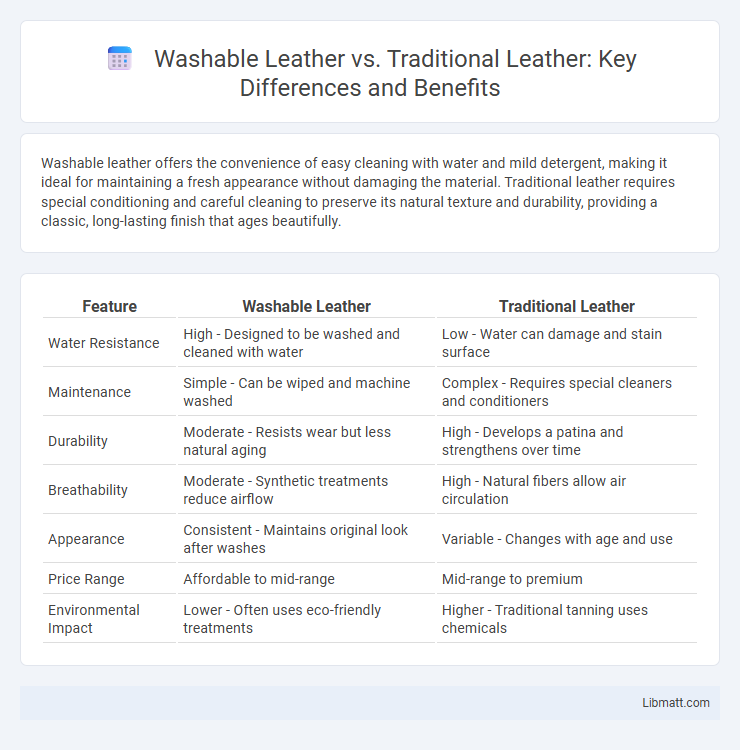Washable leather offers the convenience of easy cleaning with water and mild detergent, making it ideal for maintaining a fresh appearance without damaging the material. Traditional leather requires special conditioning and careful cleaning to preserve its natural texture and durability, providing a classic, long-lasting finish that ages beautifully.
Table of Comparison
| Feature | Washable Leather | Traditional Leather |
|---|---|---|
| Water Resistance | High - Designed to be washed and cleaned with water | Low - Water can damage and stain surface |
| Maintenance | Simple - Can be wiped and machine washed | Complex - Requires special cleaners and conditioners |
| Durability | Moderate - Resists wear but less natural aging | High - Develops a patina and strengthens over time |
| Breathability | Moderate - Synthetic treatments reduce airflow | High - Natural fibers allow air circulation |
| Appearance | Consistent - Maintains original look after washes | Variable - Changes with age and use |
| Price Range | Affordable to mid-range | Mid-range to premium |
| Environmental Impact | Lower - Often uses eco-friendly treatments | Higher - Traditional tanning uses chemicals |
Introduction to Washable Leather and Traditional Leather
Washable leather offers enhanced convenience by allowing easy cleaning with water and mild soap, making it more resistant to stains and wear compared to traditional leather. Traditional leather is prized for its natural durability, unique texture, and patina development over time, but it requires specialized care and conditioning to maintain its quality. Both materials are used in fashion, furniture, and automotive industries, with washable leather gaining popularity for its low-maintenance properties while traditional leather remains a symbol of luxury and craftsmanship.
Key Differences Between Washable and Traditional Leather
Washable leather offers enhanced convenience with its ability to be cleaned using water and mild soap, unlike traditional leather, which requires specialized conditioners and treatments to maintain its quality. The manufacturing process for washable leather incorporates protective coatings that make it more resistant to stains and moisture, whereas traditional leather retains a natural texture that can develop a patina over time. Your choice depends on whether you prioritize ease of maintenance or the classic appeal and aging characteristics of traditional leather.
Manufacturing Processes Compared
Washable leather undergoes a specialized finishing process that includes a protective topcoat, allowing it to resist stains and moisture while maintaining breathability. Traditional leather is treated through tanning, dyeing, and conditioning methods that focus on durability and natural texture but lack water-resistant coatings. Your choice impacts maintenance, as washable leather requires less care due to its resistance properties, contrasting with traditional leather's need for regular conditioning to prevent drying and cracking.
Durability and Longevity
Washable leather offers enhanced durability due to its treated surface, making it more resistant to stains and moisture compared to traditional leather, which requires regular maintenance to avoid damage. Traditional leather ages with a natural patina that can extend its longevity if properly cared for, but it is more susceptible to scratches and water damage. Choosing washable leather can improve the lifespan of your items in environments prone to spills and dirt, ensuring sustained appearance and functionality.
Maintenance and Cleaning Requirements
Washable leather requires significantly less maintenance than traditional leather, as it can be cleaned with mild soap and water without damaging the surface. Traditional leather demands regular conditioning with specialized leather care products to prevent cracking and drying. Washable leather's water-resistant coating enhances durability and makes it ideal for easy, everyday cleaning in comparison to the more delicate traditional leather.
Environmental Impact and Sustainability
Washable leather reduces environmental impact by incorporating water-resistant coatings, which extend product lifespan and decrease waste compared to traditional leather that often involves intensive tanning processes emitting harmful chemicals. Traditional leather production consumes large amounts of water and energy, contributing to deforestation and pollution, whereas washable leather offers a more sustainable alternative by minimizing resource use and enabling easier maintenance. Sustainable practices in washable leather manufacturing enhance eco-friendliness through innovative treatments that reduce chemical reliance and promote durability without sacrificing quality.
Cost Considerations
Washable leather typically has higher upfront costs than traditional leather due to advanced treatments that enhance water resistance and durability. Over time, washable leather can reduce maintenance expenses by minimizing the need for specialized cleaning and conditioning products. Traditional leather may require more frequent upkeep, leading to higher long-term maintenance costs despite its lower initial price.
Aesthetic and Design Versatility
Washable leather offers enhanced aesthetic and design versatility compared to traditional leather due to its ability to maintain a consistent, clean appearance after multiple washes. Its treatment processes allow for bolder colors, varied textures, and innovative patterns that withstand regular cleaning without fading or cracking. Traditional leather often requires careful maintenance to preserve its natural patina, limiting design experimentation and long-term aesthetic consistency.
Common Uses and Applications
Washable leather is commonly used in furniture upholstery and automotive interiors where easy maintenance and frequent cleaning are essential, making it ideal for households with children or pets. Traditional leather dominates high-end fashion, luxury car seats, and premium accessories due to its durability, natural aging process, and rich texture. Your choice depends on whether you prioritize convenience and stain resistance or classic aesthetics and long-term patina development.
Choosing the Right Leather for Your Needs
Washable leather offers enhanced convenience and easy maintenance compared to traditional leather, making it ideal for users seeking practicality without sacrificing style. Traditional leather provides a classic look, durability, and ages gracefully, suitable for those who prioritize long-term investment and authenticity. Your choice depends on factors like lifestyle, usage frequency, and desired care routine.
Washable leather vs traditional leather Infographic

 libmatt.com
libmatt.com